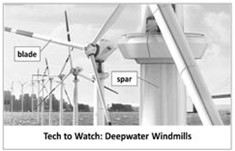



阅读理解。
 According to the US government, wind farms off the
According to the US government, wind farms off the
Pacific coast could produce 900 gig watts of electricity
every year. Unfortunately, the water there is far too deep
for even the tallest windmills (see picture) to touch bottom.
An experiment under way off the coast of Norway, however,
could help put them anywhere.
The project, called Hywind, is the world's first large-scale deepwater wind turbine (涡轮发电机). Although
it uses a fairly standard 152-ton, 2.3-megawatt turbine, Hywind represents totally new technology. The turbine
will be fixed 213 feet above the water on a floating spar (see picture), a technology Hywind's creator, the
Norwegian company StatoilHydro,has developed recently. The steel spar, which is filled with stones and goes
328 feet below the sea suce, will be tied to the ocean floor by three cable (缆索); these will keep the spar
stable and pr the turbine from moving up and down in the waves. Hywind's stability (稳定性) in the cold
and rough sea would prove that even the deepest corners of the ocean are suitable for wind power. If all goes
according to plan, the turbine will start producing electricity six miles off the coast of southwestern Norway as
early as September.
To produce electricity on a large scale, a commercial wind farm will have to use bigger turbines than Hywind
does, but it's difficult enough to balance such a large turbine so high on a floating spar in the middle of the ocean.
To make that turbine heavier, the whole spar's to design a new kind of wind turbine, one whose gearbox (变速
箱) sits at sea level rather than behind the blades (see picture).
Hywind is a test run, but the benefits for perfecting floating wind-farm technology could be extremely large.
Out at sea, the wind is often stronger and steadier than close to shore, where all existing offshore windmills are
planted. Deep-sea farms are invisible from land, which helps overcome the windmill-as-eyesore objection. If the
technology catches on, it will open up vast areas of the planet's suce to one of the best low-carbon power
sources available.
A. the cables which tie the spar to the ocean floor
B. the spar which is floating in deep-sea water
C. the blades driven by strong and steady sea wind
D. the stones filled in the spar below the sea suce
2. To balance a bigger turbine high on a flatting spar, a new type of turbine is to be designed with its gearbox
sitting _____.
A. on the sea floor
B. on the spar top
C. at sea level
D. behind the blades
3. Wide applications of deepwater wind power technology can _____.
A. solve the technical problems of deepwater windmills
B. make financial profits by producing more turbines
C. settle the arguments about environmental problems
D. explore low-carbon power resources available at sea








